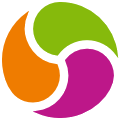|
 |
This is yet another tentative definition of what is an ontology applied for the semantic web. Before explaining that definition, I would like to continue by stating what I think is the main purpose of an ontology:
An ontology as for main purpose to communicate coherent and consistent information.
Different Kinds of Ontologies
Over the years, I tended to use the word “vocabulary,” along with the word “ontology,” in different blog posts and technical documents. However, the usage of each word may not always have been clear. Is an vocabulary an ontology? Is an ontology a vocabulary? Are these concepts synonymous? There is an important distinction to make: an ontology can be a vocabulary, but an ontology is much more than a simple vocabulary.
Ontologies can describe all kind of well-known knowledge representation structures, some simple, and others much more complex. Here is a small list of some of them:
- lexicons
- taxonomies, or
- higher order knowledge description frameworks
In its most basic usage, an ontology will define a vocabulary. It will simply define the terms (words) that belongs to that vocabulary without saying anything regarding the usage of these words.
Then, an ontology could evolve into a taxonomy by defined hierarchical relationships between the terms that compose the vocabulary.
Finally, it can evolve further to become a higher order knowledge description framework that defines more complex usage rules such as: usage restrictions, all kind of relationships between described entities, etc. New knowledge could also be inferred. It is why I say that an ontology is not strictly a simple vocabulary, but that it powerful knowledge description framework.
Knowledge Base
As we saw above, the main purpose of an ontology is to be able to create a coherent and consistent knowledge base of information that can get communicated. So an ontology is a kind of language that let you create knowledge bases that are consistent, coherent and where new knowledge can be inferred. That is done by following the usage rules defined in the ontology.
However, there is another important aspect to take into account: an ontology will describe knowledge that is coherent and consistent, but according to the own World view of that ontology. This means that two ontologies, describing the same domain of knowledge, could consistently and coherently describe information according to their view of the World.
Let’s take an example. Let’s say that two book stores developed their own ontologies to describe the books they sell. Both companies sell books. There are good chances that they will use the same vocabulary to describe their books. However, the usage rules between these terms may differ between the two book stores. One of the book stores could say that a proceeding is a specialized kind of book. But the other book store could say that no, a proceeding is not a specialized kind of book, but that it is a document just like a book. So, both would describe a proceeding as a document, but one would have different interpretation rules about what a book really is. As you see, both book stores use the same vocabulary to define their library of books, but they interpret their meaning differently. If the two stores would have to exchange information about books in the future, they won’t have many difficulties because they are probably sharing the same vocabulary, but the interpretation of that information may differ. The result of these potential differences in their interpretations may be where a book will be classified into the store; or how their customers could search for a specific book, using different filtering criterias; etc.
| This is not different than what happens in our daily lives: is there a day in your life when you don’t hear people arguing about different point of views? It is exactly the same thing that happens here. We potentially all live and see and the exact same events, images, sound, etc.; but we may all have a different interpretation of these things. |  |
Ontologies in the Open Semantic Framework?
Ontologies are so flexible that we choose to make ontologies the “brain†of the Open Semantic Framework.
We wanted to use the most flexible knowledge description framework that would enable us to integrate any possible information sources that have been describe using any existing kind of simple, or really complex, knowledge representation structures such as simple: lexicons, taxonomies, relational schemas, etc. By using ontologies as its central piece, OSF is a flexibly data integration framework that can consolidate information from various, heterogeneous, sources of information.
 |
If we remember the definition we started with, ontologies are not just about describing terms and their relationships in a coherent and consistent way. The ultimate purpose is to communicate that information. It is what the structWSF part of the Open Semantic Framework does: it let any kind of system that have access to the Internet to send, receive and manipulate information in multiple formats from a series of web service endpoints. |
More Reading
Finally, I would suggest you to read Mike’s Intrepid Guide to Ontologies to have a better understanding of where ontologies come from, how they works, what other formats exists, what are the different approaches to ontologies and what tools currently exists to work with ontologies.
Jamshaid
September 19, 2011 — 4:39 am
Hi Frederick,
Very easy to understand and practicle explanation of ontology, equally useful to a semantic web guy and for a layman.
Keep sharing such “lightweight” snacks
thanks
jamshaid
Frederick Giasson
September 19, 2011 — 9:20 am
Hi Jamshaid!
Thanks for your comment. We (Structure Dynamics) wrote at length about ontologies. However, I wanted to try one more, from a different angle using different words. I am happy to see that you liked it.
Take care,
Fred
BartG
September 19, 2011 — 6:34 pm
Frédérick,
Thanks for the great write up.
I’v often used the term folskonomy when introducing people to semantics. Tags are simple concepts to understand, but more specifically, to use. My hope here is that once people start to use folksonomies to categorise content, the leap to using a vocabulary to “tag” more granular ideas in that content will be easier.
-Bart
Frederick Giasson
September 19, 2011 — 7:00 pm
Hi Bart!
I agree with this approach for most of the users that have no prior knowledge in annotating pieces of content. This is probably one of the most natural and intuitive way to annotate things.
However, as you pointed out, the natural next step is to expose them to a folksonomy system that uses a controlled vocabulary to tag their content. This would not only help them, but it would add great power to the system(s) that uses these controlled tags (particularly if the vocabulary is more than just a vocabulary 🙂 )
Also, in my experience, we have been successful in teaching how to use ontologies to create, update and display content to clients that didn’t even know what an ontology was before starting working with the Open Semantic Framework.
Thanks!
Take care,
Fred